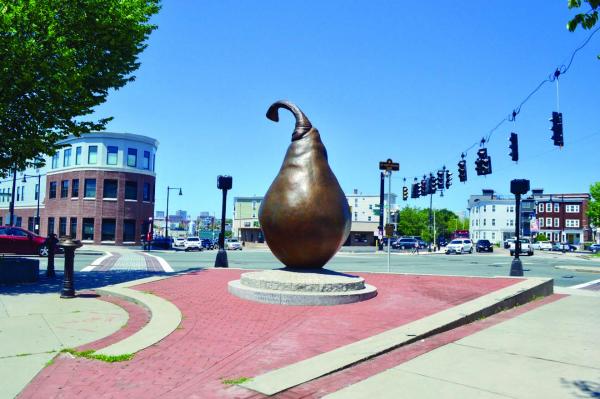July 11, 2018

“The Pear” at Edward Everett Square.
Artists will gather July 21
A summer music and art festival planned for a week from Saturday (July 21) hopes to bring renewed energy and attention to one of the neighborhood’s oldest crossroads.
The Pear Square Art Fair will run from noon until 8 p.m. at Richardson Park, a state-owned green space at Columbia Road, East Cottage, and Pond streets that is adjacent to the city’s oldest home, the Blake House, and also features a statue dedicated to one of the neighborhood’s most prominent 19th century citizens, Edward Everett.
The fair takes its name from the bronze pear sculpture that sits at the corner of Columbia Road and East Cottage Street. In the shade of the orchard at the park, leatherworkers, glassblowers, and other artists will be selling their wares to the tunes of musicians of many genres, from Fictitious Yacht People, a teenage punk band based in Brookline, to Dan Rico, an electronic pop artist from Chicago.
The Boston Typewriter Orchestra, which describes itself online as “a collective endeavor which engages in rhythmic typewriter manipulation combined with elements of performance, comedy and satire,” is expected to be one of the closing acts, taking the stage at 6 p.m.
The event was born through discussions at Dorchester North Neighborhood Association meetings around a year ago. “The park is neglected,” said Michael Keamy, a co-organizer of the upcoming fair. “We wanted to utilize it in a way that brought people onto the park physically, enjoying an event, and hopefully in the long term served to bring the park back to life.”
After a successful pilot program last summer, which featured two one-act plays by Boston Theater Works, the groundwork was laid for this year’s fair, and, hopefully, more to come.
“It let us know that we’ve got all of these resources, that the park has a lot of space to be used well, and that the neighborhood will come to events in the park,” said Vincent Rocchio, another co-organizer of the pilot program.
The fair will feature some 14 artists selling a variety of goods, and 6 to 7 musical groups playing 60-to 90-minute sets. The Banshee Pub will be selling food and there is talk of a vendor selling carnival-esque treats (think snow-cones and cotton candy). While chairs will not be provided, organizers encourage you to take advantage of the green space and bring a blanket to hang out on in the grass.
In addition, the James Blake House, constructed in 1661, will be open for exploration as part of the event. Keamy and Rocchio hope the fair will bring local interest to the park and eventually “make it more beautiful.”
The event comes a decade after Edward Everett Square’s own restoration, begun in 1995 by a neighborhood crime watch— called Neighborhood Eye— of which the Dorchester North group is a reincarnation. John McColgan, who grew up near the area and was one of the founders of the crime watch in 1981, remembers the park as a makeshift ballfield where he and his friends would play, much to the city’s chagrin. Neighborhood kids would climb the Edward Everett statue in the park, sit between its legs, “look out at the passersby and contemplate the world,” said McColgan.
“[The park] is really a different place now,” he added.
The upcoming arts fair seems to represent all of that change, and all the change to come. McColgan said it is exactly the kind of thing he envisioned when beginning restoration all those years ago, and that he “couldn’t be happier.”
Everett Square--and the giant pear
Edward Everett was born in 1794 just steps from the intersection that now bears his name— the modern-day crossroads of Boston Street, Columbia Road, Massachusetts Avenue and East Cottage Street. The house— long gone— was situated about where the Dunkin’ Donuts is now, according to Earl Taylor, president of the Dorchester Historical Society.
Everett would grow up to be a politician, pastor, educator, diplomat, and orator, though perhaps best known for his two-hour long speech directly preceding that of Abraham Lincoln at Gettysburg in November 1863.
Everett’s death in 1865 prompted the creation of a sculpture in his honor — the same one we see today, in Richardson Park (so named after the Richardson family, who purchased the Everett’s property and eventually gave a portion, today’s park, to the city).
First mounted in the Boston Public Garden, the sculpture was moved to a traffic circle in the middle of the Columbia Road-Massachusetts Avenue intersection until a couple of run-ins with motorists, most seriously in 1931, prompted its removal to Richardson Park.
Today, the square is more associated with a more eye-catching addition: the 12-foot-tall bronze pear. In 1995, a neighborhood crime watch set about beautifying Edward Everett Square, and enlisted the help of artist Laura Baring-Gould. Wanting to create something emblematic of the community’s history, she crafted the pear not only because of its past significance (the pear is modeled after a hybrid, created in Dorchester by a descendent of one of the town’s founding families, the Clapps, in the 1830s), but also because of its present symbolism: this specific fruit is known for its tough skin and sweet interior, which Baring-Gould saw as emblematic of the community.
“The whole purpose of the artwork, in my mind, is to inspire people to think about their history, to try and understand themselves and their community,” said John McColgan, who helped guide the restoration project. “When people understand their own history, it brings power to themselves and the community.”


